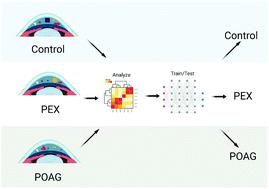当前位置:
X-MOL 学术
›
Mol. Omics
›
论文详情
Our official English website, www.x-mol.net, welcomes your feedback! (Note: you will need to create a separate account there.)
Aqueous humor metabolite profile of pseudoexfoliation glaucoma is distinctive
Molecular Omics ( IF 2.9 ) Pub Date : 2020-02-24 , DOI: 10.1039/c9mo00192a Ciara Myer 1 , Leila Abdelrahman 1 , Santanu Banerjee 2 , Ram B Khattri 3 , Matthew E Merritt 3 , Anna K Junk 4 , Richard K Lee 1 , Sanjoy K Bhattacharya 1
Molecular Omics ( IF 2.9 ) Pub Date : 2020-02-24 , DOI: 10.1039/c9mo00192a Ciara Myer 1 , Leila Abdelrahman 1 , Santanu Banerjee 2 , Ram B Khattri 3 , Matthew E Merritt 3 , Anna K Junk 4 , Richard K Lee 1 , Sanjoy K Bhattacharya 1
Affiliation

|
Pseudoexfoliation (PEX) is a known cause of secondary open angle glaucoma. PEX glaucoma is associated with structural and metabolic changes in the eye. Despite similarities, PEX and primary open angle glaucoma (POAG) may have differences in the composition of metabolites. We analyzed the metabolites of the aqueous humor (AH) of PEX subjects sequentially first using nuclear magnetic resonance (1H NMR: HSQC and TOCSY), and subsequently with liquid chromatography tandem mass spectrometry (LC-MS/MS) implementing isotopic ratio outlier analysis (IROA) quantification. The findings were compared with previous results for POAG and control subjects analyzed using identical sequential steps. We found significant differences in metabolites between the three conditions. Principle component analysis (PCA) and partial least squares discriminant analysis (PLS-DA) indicated clear grouping based on the metabolomes of the three conditions. We used machine learning algorithms and a percentage set of the data to train, and utilized a different or larger dataset to test whether a trained model can correctly classify the test dataset as PEX, POAG or control. Three different algorithms: linear support vector machines (SVM), deep learning, and a neural network were used for prediction. They all accurately classified the test datasets based on the AH metabolome of the sample. We next compared the AH metabolome with known AH and TM proteomes and genomes in order to understand metabolic pathways that may contribute to alterations in the AH metabolome in PEX. We found potential protein/gene pathways associated with observed significant metabolite changes in PEX.
中文翻译:

假性剥脱性青光眼的房水代谢产物特征明显
假性剥脱(PEX)是继发性开角型青光眼的已知原因。PEX青光眼与眼睛的结构和代谢变化有关。尽管有相似之处,但PEX和原发性开角型青光眼(POAG)的代谢物成分可能有所不同。我们首先使用核磁共振先后分析了PEX受试者房水(AH)的代谢产物(11 H NMR:HSQC和TOCSY),随后用液相色谱串联质谱法(LC-MS / MS)进行同位素比率离群值分析(IROA)定量。将结果与POAG的先前结果进行比较,并使用相同的连续步骤对对照组进行了分析。我们发现三种情况之间的代谢产物存在显着差异。主成分分析(PCA)和偏最小二乘判别分析(PLS-DA)显示基于这三种情况的代谢组的清晰分组。我们使用机器学习算法和一定百分比的数据进行训练,并利用其他或更大的数据集来测试经过训练的模型是否可以将测试数据集正确分类为PEX,POAG或控件。三种不同的算法:线性支持向量机(SVM),深度学习,和神经网络用于预测。他们都基于样品的AH代谢组对测试数据集进行了准确分类。接下来,我们将AH代谢组与已知的AH和TM蛋白质组和基因组进行了比较,以了解可能有助于PEX中AH代谢组改变的代谢途径。我们发现潜在的蛋白质/基因途径与PEX中观察到的重要代谢物变化相关。
更新日期:2020-02-24
中文翻译:

假性剥脱性青光眼的房水代谢产物特征明显
假性剥脱(PEX)是继发性开角型青光眼的已知原因。PEX青光眼与眼睛的结构和代谢变化有关。尽管有相似之处,但PEX和原发性开角型青光眼(POAG)的代谢物成分可能有所不同。我们首先使用核磁共振先后分析了PEX受试者房水(AH)的代谢产物(11 H NMR:HSQC和TOCSY),随后用液相色谱串联质谱法(LC-MS / MS)进行同位素比率离群值分析(IROA)定量。将结果与POAG的先前结果进行比较,并使用相同的连续步骤对对照组进行了分析。我们发现三种情况之间的代谢产物存在显着差异。主成分分析(PCA)和偏最小二乘判别分析(PLS-DA)显示基于这三种情况的代谢组的清晰分组。我们使用机器学习算法和一定百分比的数据进行训练,并利用其他或更大的数据集来测试经过训练的模型是否可以将测试数据集正确分类为PEX,POAG或控件。三种不同的算法:线性支持向量机(SVM),深度学习,和神经网络用于预测。他们都基于样品的AH代谢组对测试数据集进行了准确分类。接下来,我们将AH代谢组与已知的AH和TM蛋白质组和基因组进行了比较,以了解可能有助于PEX中AH代谢组改变的代谢途径。我们发现潜在的蛋白质/基因途径与PEX中观察到的重要代谢物变化相关。


























 京公网安备 11010802027423号
京公网安备 11010802027423号